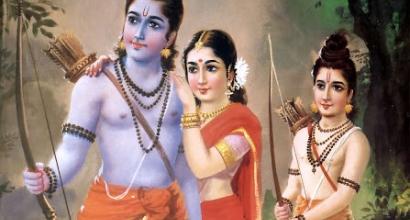By the time of Kālidāsa, the role and characteristic features of the vidūṣaka had taken a concrete form. The vidūṣaka in the Vikramorvaśīyam is endowed with quite a few profound qualities. One can see some of his weaknesses as well; he cannot keep a secret. The segments where the clever Nipuṇikā deceives him and the way in which he tries to hide his stupidity before the king are comical. To convince Āyuḥ Kumāra that he need not fear him, the vidūṣaka compares himself to a monkey – this certainly tickles the connoisseur’s bones. Kālidāsa makes his vidūṣaka and the king speak about the glory of svarga [1]and the qualities of maharṣis[2]– it reflects the happy mental landscape of Kālidāsa and pleases connoisseurs. One must not interpret these statements of the poet as those stemming out of contempt or ridicule; it is merely a comical take on the nature of the divinities and the sages. It is common to find this kind of casual humour in the works of many poets of our country – they are, in this sense, unique, novel, and ‘modern.’
The Abhijñāna-śākuntalam is a play based on the romantic love of a king, just like the Mālavikāgnimitram and Vikramorvaśīyam; however, it is of a much different flavour. It reveals the skills that Kālidāsa has developed out of experience in writing the other plays – we can see that the plot of Abhijñāna-śākuntalam is much more nuanced and well-sculpted; the characters are deeper and the storyline is more profound than the other plays. It merits all applause and celebration for the emotional nuances and the perspective of universal human values that it reveals. Though it was composed in India, because of its artistry, it has won the hearts of people around the globe. Thanks to its supreme qualities, it was translated into English back in 1789 by Sir William Jones; the work was introduced to the West through his translation and immediately received appreciation. The play opened doors to the Europeans for an exclusive study of the Sanskrit language and literature. It is interesting to note how a play can inspire generations of scholars to take up the study of Indian literature and aesthetics.
The raw material for the story is found in the Ādi-parva of the Mahābhārata[3]. The following the summary of the story –
Once, King Duṣyanta, who is out hunting, chases after a deer and comes to the banks of the river Mālinī; there, he happens to come upon Kaṇva’s āśrama, but the sage wasn’t home; he had gone out to fetch fruits and roots. Duṣyanta calls out, “Who’s there?” In response, Śakuntalā steps out and hosts him well; she offers him waters for arghya and pādya. Duṣyanta is besotted by her beauty and introduces himself to her; since he was sure that his mind would never fall for a woman who did not belong to a kṣattriya clan, he asks who she was. She says that she was born to Viśvāmitra and Menakā and was abandoned by them; she was then nurtured by śakuntas, i.e., birds, and thus, Sage Kaṇva named her Śakuntalā. She adds that she can marry only with the approval of her foster father, the sage. However, Duṣyanta insists that kṣattriyas could marry in the gandharva fashion and that Kaṇva would not object it; finally, Śakuntalā says that she would agree to his advances only if he promised her that the child born to her would succeed him as the king. Duṣyanta agrees, marries her, and spends a few days with her. He tells her that he would welcome her into his capital city in a way befitting a royal couple; he promises to send clothes and jewellery that befit her as well as servants to take care of her. Having given his word, he leaves for his home town.
Once Kaṇva returns, he learns of the incidents that had taken place in his absence and supports them. Śakuntalā eventually gives birth to a son. The rituals of jāta-karmā and nāma-karaṇa take place in the āśrama. He grows up into a lad of twelve years. Still, Duṣyanta does not send for Śakuntalā. In the beginning, he was worried about what Kaṇva would say; in the due course of time, he simply forgot about her. However, Śakuntalā always thought of him and craved for his company. The boy displayed immense valour right from a young age. He tamed wild animals and was nicknamed savra-damana; looking at the boy’s nature, Sage Kaṇva decided that he possessed all he qualities required to be the crown-prince and that it was rather appropriate for Śakuntalā to head to her husband’s place, even though he hadn’t sent for her. He saw her off with her son and sent a few of his students to escort her to Duṣyanta’s kingdom. They arrived at the Pratiṣṭhā-nagara, which was about two yojanas away from the āśrama; people belonging to the city found the appearance and mannerisms of these ascetics strange and started ridiculing them. Feeling disgruntled with the behaviour of the citizens, Kaṇva’s students left her there and went back to their āśrama. Though Śakuntalā was sad at first, she gathered courage and went to Duṣyanta’s court. The king was seated on his throne; Śakuntalā stood before him and narrated everything about herself. Upon listening to her, though Duṣyanta was able to recollect everything of the past, he declared that he knew nothing of her; he did so because he was scared of being retributed by the world. Śakuntalā felt embarrassed, helpless, and orphaned for a moment; however, she bottled up courage and her eyes turned red. With her lips quivering out of anger, she challenged Duṣyanta and declared that his head would break apart into a thousand pieces if he ignored her words; she tried to remind him of the events of the past in various ways; she also preached dhārmic values. She says that she does not mind going back to the āśrama, but wanted Duṣyanta to accept her (their) son. Nothing could change Duṣyanta’s mind and he even calls her a prostitute’s daughter. In response, Śakuntalā says that Duṣyanta was born in the lineage of apsarās such as Urvaśī, who is like a prostitute of the divinities. She tried everything she could – she tried to pacify him through pleading words and also by threatening him, but Duṣyanta wouldn’t budge; she pacified the fire of her anger and started back with her son.
Suddenly, an incorporeal voice was heard from the skies; the voice could be heard by everyone in the royal assembly; it declared that everything that Śakuntalā had said was true; there was a shower of flowers upon her. Duṣyanta then stepped down from the throne and said, “I have always known that she is my wife and this is my son. However, if I accept her just from her words, the world may suspect my character and people might not even trust my son to be of pure birth. Hence, I pretended to reject them.” After explaining so, he welcomed his wife and son. He crowned Sarvadamana as the prince; he later became famous by the name Bharata.
To be continued ...
The current series of articles is an enlarged adaption of Prof. A. R. Krishnasastri's Kannada treatise Saṃskṛta-nāṭaka. They are presented along with additional information and footnotes by Arjun Bharadwaj.
[1] kiṃ vā svarge smartavyam? na tatra khādyate na pīyate kevalam-animiṣairakṣibhirmīnatāvalambyate| (Act 3)
[2] Vedābhyāsa-jaḍaḥ kathaṃ sa viṣaya-vyāvṛtta-kautūhalo… purāṇo muniḥ (1.10)
[3] The Śakuntalopākhyāna appears in the Padma-purāṇa (Svarga-khaṇḍa, adhyāya 1 – 5) However, in Haradatta-śarmā words, it is unlikely that the version in the Padma-purāṇa was the source for Kālidāsa’s Abhijñāna-śākuntalam (Padmapurana and Kalidasa, Calcutta, 1925). It appears as if Padma-purāṇa was composed, inspired by the Mahābhārata and Kālidāsa’s play. The version in the purāṇa combines the two narratives – like the Mahābhārata, Śakuntalā demands from Duṣyanta that her son must occupy the throne and like in the play, Durvāsa curses her and the episode connected with ring ensues; additionally, the fisherman being caught with the ring is included; the characters of Priyaṃvadā, purohita, Mātali, Kaśyapa, and a merchant occur. The storyline is more or less that of Kālidāsa’s play. Many dialogues from the play appear verbatim in the Padma-purāṇa.











































